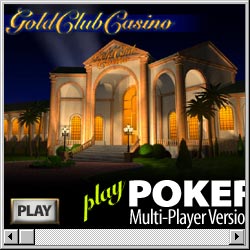
HOW TO PLAY VIDEO POKER

Basic Rules:
Draw poker and five card stud were once the most common forms of poker. Although they are now virtually extinct at the poker table, five card draw poker is enjoying a resurgence in the form of a variety of video games.
Nevada casinos average about 60% of their hold from
slot machines, and in some casinos up to two-thirds of those machines
are now video poker. It's not uncommon for a large casino to have more
than one thousand video poker machines.
Video poker is unique in being one of very few games that were developed
for casino use before being played privately. As in live draw poker, you
are initially dealt five cards from a randomly shuffled deck. Most machines
beep and indicate if you have a made paying hand, but you do not have
to hold that hand. You select which cards to hold, then press the Draw
button, and new cards are dealt off the top of the deck to replace the
discards. If the final hand is in the payoff schedule, the machine makes
the payoff, either by counting up credits or dropping coins; otherwise,
your bet is lost.
The main attraction of video poker to the neophyte is that the player's
wits are pitted against the machine in fast action with a chance at a
big jackpot. To the skilled player, however, the attraction is that some
games offer an opportunity for a long term profit. Just as in a live poker
game, there is a considerable amount of risk and luck involved in the
short term, but it is a player's skill that will make the difference between
a winner and a loser in the long run.
You may already know that some video poker games offer over 100% potential
long term payback, but you will achieve a game's rated payback only if
you always hold the cards that will give the highest expected value (the
average payback for all possible outcomes) for each hand you are dealt.
That is why I call video poker "The Intelligent Player's Slot Machine."
Video poker vs. slot machines
A video poker machine resembles the traditional slot machine in several
ways, being housed in a similar metal cabinet with similar locks; most
have a coin slot to accept your bet and a coin hopper that pays out your
winnings; and it makes various sounds to attract players. Many have a
slot club card reader and/or a bill acceptor.
The most obvious difference is that on a reel slot the player wins when
the symbols stop with a particular combination, such as three bars, while
a video poker player wins when the final five cards form a recognizable
poker hand, such as a straight. The most important difference, however,
is that the video poker player has an opportunity to select which cards
to hold and then draw in an attempt to improve the hand. A certain degree
of skill is required in this selection process to achieve the game's rated
payback.
In either case, all of the winning combinations with their respective
payoffs are shown on the front of the machine or on the screen, and the
machine automatically pays out the indicated number of coins or counts
up that number of credits when one of those combinations occurs.
What most players don't know (or at least won't consciously admit to themselves)
is that, unlike older machines which were randomized mechanically and
the result undetermined until the reels actually stopped, the reels on
all modern machines are spun by independent motors to display an outcome
that has already been determined by a random number generator.
Many casinos advertise 97% or better payback on reel slots, but this often
applies only to certain $1 machines. Care to guess what the payback is
on the others? Without knowing the machine's internal logic it's impossible
to calculate, but if 97% payback is considered generous then what do the
others pay? Nevada gaming regulations specify only that a machine must
pay back at least 75% of all money wagered (see Appendix 4). In New Jersey
the minimum is 83%. Many other jurisdictions do not specify a minimum
payback. Worse, many new gambling areas specify a maximum payback under
100%. They typically say that it's to prevent skimming (e.g., by setting
a machine to pay well over 100% for a crony), but more likely to assure
a flow of tax dollars. Just who is it that our government is protecting?
Compare the very best reel machine's maximum of perhaps 99% payback to
a minimum of 99% payback with optimum strategy any of the recommended
video poker games. But that's just the beginning. On many poker machines
you really can achieve over 100% long term payback.
But don't get the idea that careful selection of games and accurate play
are only for long term players. Sure, it's possible to be a winner on
a low paying game. A small percentage of players win big every day at
craps, roulette and slot machines. The casinos publicize this to attract
more losers. While it's true that luck predominates in any short playing
session, it's skill that makes the difference between a winner and a loser
in the long run. That same skill also increases your chances of being
a winner in each playing session, no matter how much or how little you
play.
Video poker vs. live table poker
As in live table poker, the cards are dealt from a standard 52 card deck
(53 in Joker Wild games) that is well shuffled before each hand. After
being dealt your initial five cards, you must decide which cards to hold
and which to discard in an attempt to effect a winning poker hand (or
to improve an existing winner) just as you would do in a live draw poker
game. But there the similarity ends.
So just how is video poker different? Consider the following:
o In video poker the house is banking the game, yet the machine is not
trying to beat your hand. It's more a game of solitaire. Attempting to
bluff or to "read" your opponent is pointless since there are
no opponents.
o You can't get a "bad beat" in video poker. Your straight can't
lose to that flush on another player's machine. It will always win according
to the payoff schedule.
o Some plays that may sometimes be correct in table poker become costly
mistakes in video poker. One of the most common errors is holding a "kicker"
or other worthless cards.
o Conversely, many plays that are correct in video poker would be wrong
in live table poker. In some cases, for example, it's correct to draw
to an inside straight.
It is primarily these characteristics that lure most players into making
bad plays, thus making video poker a big winner for the casino, even on
games that offer over 100% potential payback. In this section, however,
you will learn just how easy it is to keep the house edge to a minimum,
and in some cases to even enjoy the prospects of being a long-term winner.
Full pay vs. short pay machines
Only a small percentage of the wide variety of games can be beat in the
long run, so you must first learn how to recognize those games. I frequently
see someone playing a short-pay machine when the one next to it is the
same basic type but full-pay, yet it sits idle. All that is necessary
is to know the full pay schedules for the games you like, and play only
those games. We will be discussing various ways that the payoff schedules
are shorted in the specific game sections which follow.
Although games offering over 100% payback may be rare outside southern
Nevada, an accurate playing strategy is important wherever you play. Even
if you choose to play where high paying games are not available, following
an optimum strategy will minimize your losses and give you the best chance
of having a winning session. Don't be taken in by some books' claims of
teaching you how to beat the slots or any other negative expectation game.
Each game has an inherent maximum payback that can be closely approached
but never exceeded.
What is Expected Value?
To put it in as simple terms as possible, the expected value (commonly
abbreviated EV) of any chance event is the weighted average of all possible
outcomes. Let's see how to determine the EV of a video poker play.
There are thirty-two possible ways to play any dealt five-card hand. You
can hold all five cards (that's one way), hold four cards and draw one
(obviously there are five possible one-card discards), hold two cards
and draw three (there are ten possible combinations for a two-card discard),
hold three cards and draw two (again ten possibilities), hold one card
and draw four (there are five ways to hold just one card), or discard
all five cards. In any case, we have seen five of the 52 cards in the
deck, so the draw must come from the remaining 47 unseen cards.
For each of these thirty-two ways of playing a hand there are many possible
outcomes. Suppose, for example, that the card ranks in a dealt hand are
J-9-10-J-Q. Of course, they could be in any order. Here you have a pair
of jacks, which in some games is a made payoff, but that may not be the
best way to play the hand. Is it better to hold 9-10-J-Q and draw for
a straight?If the 9-10-J are all the same suit, is it better to drop the
pair and go for the straight flush draw? And if the J-Q are suited, should
we draw for a royal flush? I can't answer those questions yet, because
the best play is often different for different games.
Note that if we draw for the straight it's also possible to catch a J
or Q for a high pair, and if we go for the straight flush we could also
end up with a high pair, three of a kind, a straight or a flush. And drawing
three cards to the J-Q has many more possibilities. The probability of
every possible outcome must be multiplied by its respective payoff, and
the sum of all these possible results is the EV of the play.
There are 28 other ways to play this hand, but for most games these four
give the highest expected values. The actual EV's, however, depend upon
the particular game's payoff schedule, so the best way of playing the
hand varies between games. To create a playing strategy, we have to examine
many such card combinations and determine the highest EV plays. This allows
us to build a hand rank table which can be used as a playing strategy.